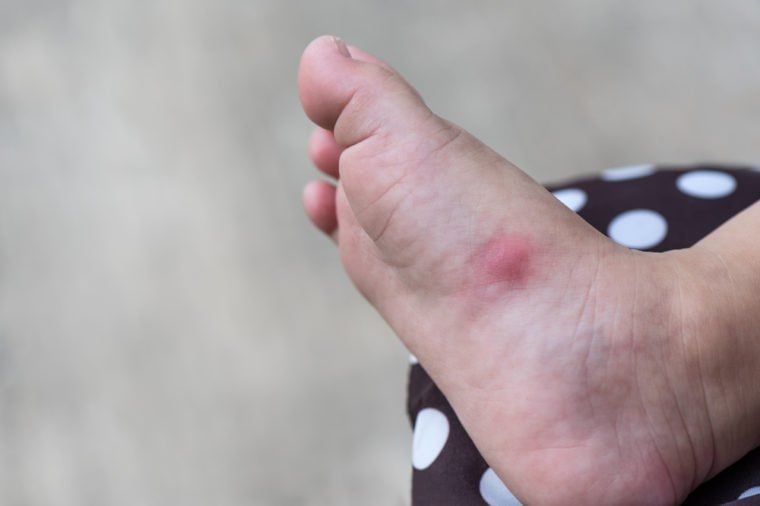
Here are various causes of a rash on legs. Due to the discomfort, whether it’s from your skin being inflamed, discolored and red, itchy, dry, or irritating, it’s something you just can’t ignore.

A rash may cause spots that are bumpy, scaly, flaky, or filled with pus.
What can cause a rash on my feet. Baking soda is a natural cooling agent and gives a soothing relief to itching rashes. Read below for more information on lower leg rashes and treatment options. This fungal infection can cause itchy rash on top of foot.
1 rashes can occur anywhere you have skin, but rashes on the feet can be especially annoying, since shoes can exacerbate the problem. Scratching or rubbing is strictly forbidden for any type of skin rash, as it can cause open wounds or blisters, which can get infected. Other causes of red blotches on the lower legs can arise from an allergic reaction to certain foods or contact with poisonous plants.
The rashes can develop when sweats are trapped under the skin in clogged skin pores. Just mix the baking soda in cold/ room temperature water and soak your foot for about half an hour for maximum relief. Most rashes on the lower leg are caused by dermatitis, eczema, or an allergic reaction which will look like red, itchy bumps on the leg.
The more you scratch, the tougher it will be to treat the problem, because the skin will become thicker and harder. Many insects can cause a rash through a bite or sting. With this condition, you will develop itchy, scaly, red foot rash that will also cause a burning or stinging.
Eczema can cause itchy, scaly rashes, as well as blisters on the soles of your feet. A rash on the soles of the feet and palms. 6) finally, rashes can be triggered by topical medications, especially antibiotic creams and even antifungal creams.
Here are various causes of a rash on legs. Cellulitis is a bacterial infection that develops in the deep layers of the skin and on the lower legs and feet. The symptoms can become painful and last for several weeks to months in some patients.
Psoriasis rashes are usually characterized by white, scaly spots. You are likely to develop this problem due to tight shoes, sweaty feet, and damp footwear. Many health conditions can cause rashes on the feet.
A foot rash is just plain annoying. The usual cause of rash or skin lesions on the feet is an infection, whether it’s fungal, bacterial, or viral. Skin rashes on the legs causes.
A skin rash on one lower leg can appear red, blotchy, or have a dry and scaly texture. Rash on your legs can occur due to certain diseases, skin disorders, or conditions. If your feet are too moist, you can avoid rashes by using foot powder daily to prevent excessive sweat.
This is likely due to an inflammatory response affecting the blood vessel walls, blood cells or a combination of both. Although the reaction will vary depending on the person and the animal, symptoms often include: The hot and humid condition is a risk factor that can cause heat rash.
These are common causes of red spots on legs of infants, toddlers or young babies. Simple irritation or allergic reactions are also a fairly common cause of the rash. Conditions like eczema can cause skin damage, red patches on legs, cracking, bleeding, or change the texture of your skin.
A rash may cause spots that are bumpy, scaly, flaky, or filled with pus. Lupus can also cause vasculitis which can cause petechiae rashes to affect the legs. Rashes can also be the result of a skin condition, such as psoriasis or eczema.
Sometimes these skin conditions have similar characteristics, which makes them tricky to identify or to. Read below for more information on on other causes, related. Common causes of rashes on the hands and feet.
Neosporin is the brand name for neomycin, a type of antibiotic. Read below for more information on causes and treatment options for foot redness. Under rare cases, teens and adult may develop a heat rash.
Sunburn causes a rash on top of the feet when you lose protection from your sunscreen and expose your feet to the ultraviolet rays for a period of time 1. So here below are some of the guidelines to ease comfort and speed up the healing process. The rash and redness appear within 12 to 24 hours after exposure and may be worse if you take certain medications such.
Hand, foot, and mouth disease. Rashes can vary in location, pattern and extent and may occur in any area of the body. What causes a rash on the bottom of my feet?
If a person is allergic to neosporin [a fairly common cause of allergy] and has been using it on their feet, they can develop a rash on their feet. Contagious infection caused by several viruses, including the coxsackie virus. The most common type of infections that cause red spots on feet are athlete's foot and cellulitis.
If your feet are dry, you can prevent rashes and infections by using a moisturizer. Hand, foot, and mouth disease is a viral infection that can cause red lesions on the mouth and a rash on the hands and feet. The h1n1 influenza a virus can also result in tiny purple spots on the skin similar to a petechial rash.
Due to the discomfort, whether it’s from your skin being inflamed, discolored and red, itchy, dry, or irritating, it’s something you just can’t ignore. Infants and children up to 5 years old are particularly susceptible to hand, foot and mouth disease, which is caused by a virus.